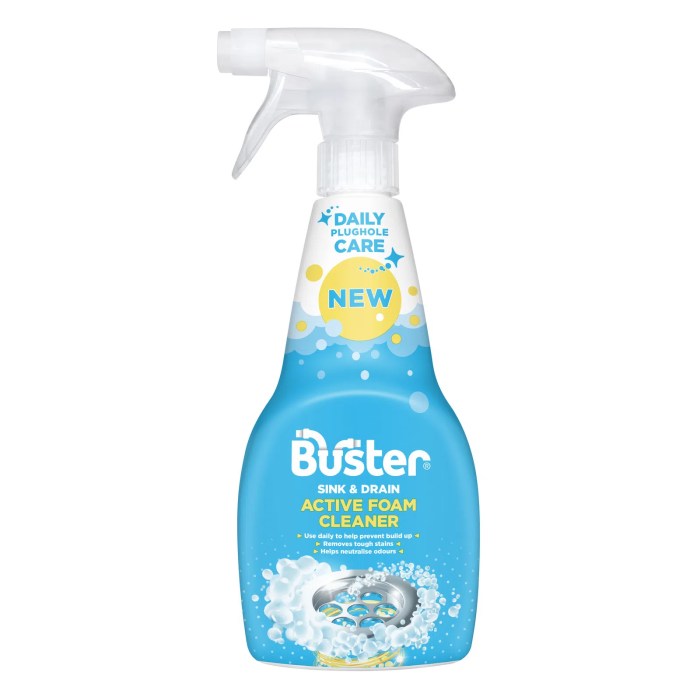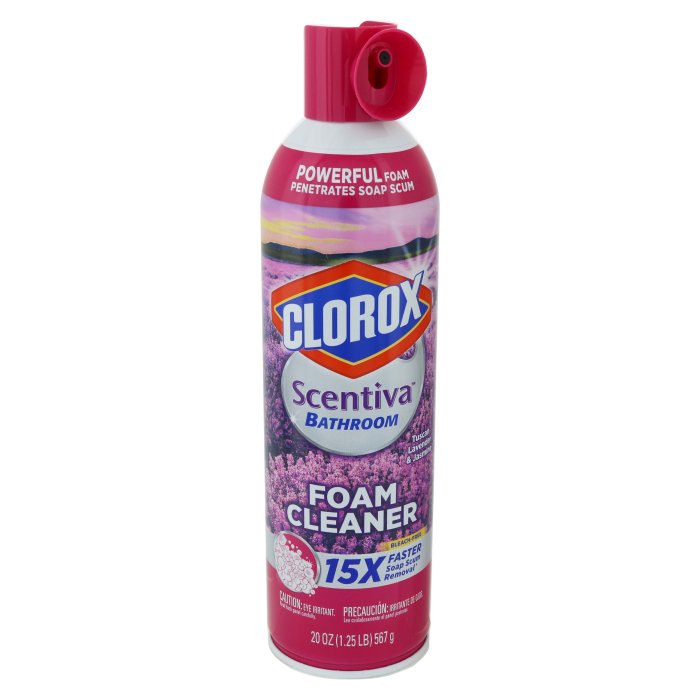Step into the world of foam sink cleaners, where pristine sinks await. This guide delves into the depths of these cleaning marvels, empowering you with the knowledge to conquer even the toughest sink stains and residues.
From understanding their chemical composition to mastering application techniques, this comprehensive exploration leaves no stone unturned in the pursuit of sparkling sinks.
Foam Sink Cleaner Properties
Foam sink cleaners are powerful cleaning agents designed to remove dirt, grime, and grease from sinks and other bathroom surfaces. They are typically composed of a combination of surfactants, solvents, and other ingredients that work together to break down and dissolve dirt and grime.
Chemical Composition
- Surfactants:Surfactants are the primary cleaning agents in foam sink cleaners. They are molecules that have both hydrophilic (water-loving) and hydrophobic (water-hating) ends. This allows them to dissolve both water-based and oil-based dirt and grime.
- Solvents:Solvents are liquids that can dissolve other substances. They are used in foam sink cleaners to help dissolve grease and other stubborn stains.
- Other Ingredients:Foam sink cleaners may also contain other ingredients, such as fragrances, dyes, and pH adjusters.
Physical Properties
- Viscosity:Foam sink cleaners are typically viscous liquids, meaning they flow slowly. This helps them to cling to surfaces and provide a longer contact time for cleaning.
- Density:Foam sink cleaners are typically denser than water, which helps them to penetrate and dissolve dirt and grime.
- pH:Foam sink cleaners are typically acidic or alkaline, with a pH ranging from 2 to 12. The pH of the cleaner will determine its effectiveness against different types of dirt and grime.
Cleaning Mechanisms
- Surfactant Action:Surfactants work by reducing the surface tension of water, which allows it to penetrate and dissolve dirt and grime. They also form micelles, which are spherical clusters of surfactant molecules that trap and remove dirt and grime.
- Degreasing Abilities:Solvents work by dissolving grease and other oily stains. This helps to remove stubborn stains and leave surfaces clean and shiny.
Types of Foam Sink Cleaners

Foam sink cleaners are available in a variety of types, each with its own unique set of active ingredients and effectiveness against different types of stains and residues.
Based on Active Ingredients
- Bleach-based foam sink cleanerscontain sodium hypochlorite, a powerful oxidizing agent that kills bacteria and disinfects surfaces. They are effective against a wide range of stains, including mold, mildew, and rust.
- Ammonia-based foam sink cleanerscontain ammonia, a strong alkaline solution that breaks down grease and grime. They are effective against grease and food residue, but should not be used on surfaces that are sensitive to ammonia, such as aluminum.
- Enzyme-based foam sink cleanerscontain enzymes, which are proteins that break down organic matter. They are effective against food residue, grease, and other organic stains.
Effectiveness Against Different Types of Stains and Residues
The effectiveness of different types of foam sink cleaners against different types of stains and residues varies. Bleach-based cleaners are the most effective against mold, mildew, and rust, while ammonia-based cleaners are the most effective against grease and food residue.
Enzyme-based cleaners are effective against a wide range of stains, but are not as effective against bleach- or ammonia-based cleaners against specific types of stains.
Selecting the Appropriate Foam Sink Cleaner
When selecting a foam sink cleaner, it is important to consider the type of stain or residue you are trying to remove. If you are dealing with mold, mildew, or rust, a bleach-based cleaner is the best choice. If you are dealing with grease or food residue, an ammonia-based cleaner is the best choice.
If you are dealing with a variety of stains, an enzyme-based cleaner is a good option.
Application Methods for Foam Sink Cleaners

Using foam sink cleaners effectively requires proper application techniques to achieve optimal results while ensuring safety. Here are the key steps involved:
Preparation, Foam sink cleaner
- Clear the sink of any debris or standing water.
- Wear protective gloves to prevent skin irritation.
- Ensure adequate ventilation by opening windows or using a fan.
Application
- Apply the foam cleaner directly to the sink surface using a sponge or cloth.
- Allow the foam to sit for the recommended time, typically around 5-10 minutes.
- Agitate the foam gently with a brush or sponge to enhance cleaning action.
Rinsing
- Rinse the sink thoroughly with warm water to remove all traces of cleaner.
- Use a clean cloth to wipe down the sink and dry it.
Specific Sink Types
While foam sink cleaners are generally safe for most sink materials, it’s important to consider the specific type of sink when choosing and applying the cleaner:
- Porcelain sinks:Use mild foam cleaners and avoid abrasive sponges.
- Stainless steel sinks:Use foam cleaners designed for metal surfaces and wipe in the direction of the grain.
- Composite sinks:Follow the manufacturer’s instructions for cleaning and avoid using harsh chemicals.
Environmental Considerations for Foam Sink Cleaners
Foam sink cleaners, like any chemical product, have environmental implications that must be considered. Understanding their biodegradability, potential toxicity to aquatic life, and comparing the environmental friendliness of different types is crucial. Additionally, adopting practices to minimize the environmental impact of foam sink cleaner use is essential.
Biodegradability and Aquatic Toxicity
Biodegradability refers to the ability of a substance to be broken down by natural processes into simpler, less harmful compounds. Foam sink cleaners vary in their biodegradability, with some being more readily biodegradable than others. Choosing biodegradable products reduces the persistence of these chemicals in the environment and minimizes their potential impact on ecosystems.
Aquatic toxicity assesses the harmful effects of a substance on aquatic organisms. Some foam sink cleaners contain ingredients that can be toxic to fish, invertebrates, and other aquatic life. These chemicals can accumulate in water bodies, affecting the health and survival of aquatic ecosystems.
Foam sink cleaner is an effective and convenient way to keep your sink sparkling clean. It is easy to use and leaves no residue behind. If you are looking for a comfortable and supportive night’s sleep, a koala mattress may be the perfect choice for you.
Koala mattresses are made with high-quality materials and are designed to provide optimal support and comfort. They are also hypoallergenic and dust mite resistant, making them a great choice for people with allergies. After a good night’s sleep on your koala mattress, you can use foam sink cleaner to quickly and easily clean your sink, leaving it sparkling clean and ready for the next day.
Selecting foam sink cleaners with low aquatic toxicity helps protect aquatic life.
Comparing Environmental Friendliness
Different types of foam sink cleaners have varying environmental impacts. Some are formulated with more environmentally friendly ingredients, such as plant-based surfactants and biodegradable solvents. These products have a lower environmental footprint compared to those containing harsh chemicals or non-biodegradable ingredients.
Consider the following factors when comparing the environmental friendliness of foam sink cleaners:
- Biodegradability
- Aquatic toxicity
- Ingredient composition
- Packaging materials
Reducing Environmental Impact
Several practices can help reduce the environmental impact of foam sink cleaner use:
- Use biodegradable products
- Follow recommended dosage instructions to avoid overuse
- Dispose of empty containers properly
- Consider using natural cleaning alternatives, such as baking soda or vinegar
By adopting these practices, we can minimize the environmental footprint of foam sink cleaners and contribute to a cleaner, healthier environment.
Alternatives to Foam Sink Cleaners
Foam sink cleaners are convenient and effective, but they can be harsh on the environment and your health. Fortunately, there are several natural and eco-friendly alternatives that are just as effective.
Baking Soda
- Baking soda is a mild abrasive that can remove tough stains and residues without scratching the sink.
- To use, sprinkle baking soda on a damp sponge and scrub the sink in circular motions.
- Rinse thoroughly with water.
Vinegar
- Vinegar is a natural disinfectant that can kill bacteria and mold.
- It is also effective at removing mineral deposits and soap scum.
- To use, pour 1 cup of vinegar into the sink and let it sit for 15 minutes.
- Scrub the sink with a brush or sponge, then rinse thoroughly with water.
Lemon Juice
- Lemon juice is a natural degreaser that can remove grease and oil from the sink.
- It is also a mild disinfectant.
- To use, squeeze the juice of 1 lemon into the sink and scrub with a sponge.
- Rinse thoroughly with water.
Final Summary

As we bid farewell to the realm of foam sink cleaners, remember that the quest for spotless sinks is an ongoing endeavor. Embrace the tips and insights shared within these pages, and your sinks will forever gleam with an unmatched radiance.
FAQ Resource
Are foam sink cleaners safe for all types of sinks?
While most foam sink cleaners are suitable for various sink materials, always consult the product label for specific instructions. Some cleaners may not be compatible with certain finishes or surfaces.
How often should I use a foam sink cleaner?
The frequency of use depends on the level of sink usage and the severity of stains. For regular maintenance, weekly cleaning is recommended. For heavily soiled sinks, more frequent cleaning may be necessary.
Are there eco-friendly alternatives to foam sink cleaners?
Yes, there are several natural and eco-friendly alternatives to foam sink cleaners, such as baking soda, vinegar, and lemon juice. These alternatives are not only effective but also gentler on the environment.